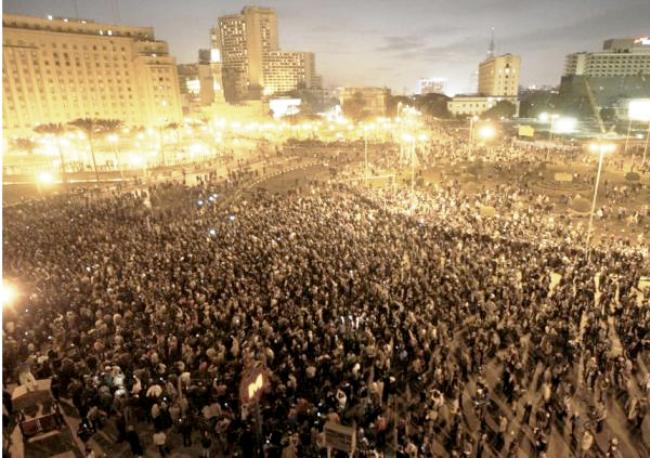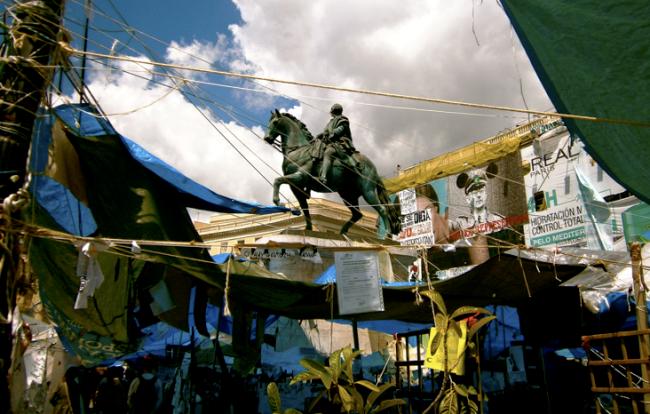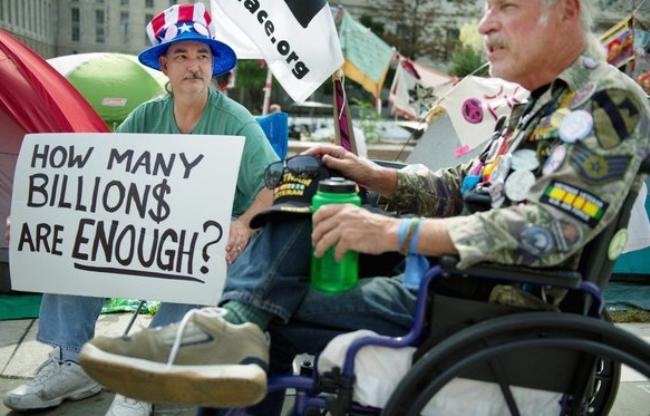What Occupy Wall Street Can Learn From The Arab Spring And Los Indignados

From the far right to the far left, anti-Wall Street activists across the nation have been fodder for equal amounts of primetime praise and condemnation. Many attribute the movement’s accelerated popularity to shared economic suffering and frustrations coupled with the web and mobile-centric social mobilization movement that swept through Egypt in the height of the Arab Spring and drifted north onto Spanish soil the following summer.
Unsurprisingly, as both the media and Occupy Wall Street (OWS) try to derive distinct meaning from the multifarious movement, some misleading comparisons are being made between the 21st century American attempt at national protest and the spring and summertime predecessors in Spain and the Middle East. However, these movements have operated within their own spheres stemming from specific national economic and political contexts. If they continue to falsely analogize many aspects of the Spanish acampadas and the Egyptian protests to what is currently happening in Wall Street without fully understanding and learning from their unique circumstances, the Occupy Wall Street Movement will fail before it can even come to fruition.
While the claim can be made that Egyptians and Americans are both fighting against government corruption, some of the more salient facts pertaining to Egypt suggest more contrasts than comparisons. For example, thirty years of continuous emergency law that allowed for the suspension of constitutional rights, legalized censorship, increased police powers, and sentencing to indefinite imprisonment without reason left many Egyptians suffocating at the hands of the unscrupulous Mubarak regime.
As Mubarak and his National Democratic Party cronies enjoyed Egypt’s wealth (Mubarak and his family’s net worth ranges from $40-$70 billion), approximately 40% of the population lived on around two dollars a day. Furthermore, with the number of new people entering the job force annually at about 4%, a college graduate was ten times likelier to be unemployed than someone who only completed elementary school. Coupled with an absurdly high inflation rate of 12.8%, the outlook was not only grim, it was fatal.
As a result, most Egyptians rightfully distrusted the Mubarak government. In 2010, Transparency International rated Egypt’s Corruption Perceptions Index as 3.1, with a score of “0” being completely corrupt and “10” being very clean (for comparison’s sake, the United States is nestled safely between Belgium and Uruguay with a 2010 score of 7.1). The Egyptian people had enough.

Gathering en masse, the Egyptians mobilized themselves to Tahrir Square to protest and demand change in the Mubarak government. There were at least six accounts of self-immolation, 846 deaths, and over 6,000 injuries. Not to let these casualties occur in vain, the Egyptian resistance crafted an articulate series of demands that aided in their national and international legitimization. The movement also had a martyr who crystallized the struggle of everyday Egyptians and the ruthlessness of the Mubarak government: Khaled Saeed. Grotesquely beaten to death by security forces, Saeed’s post-mortem photo became a domestic and international symbol for the struggle for democracy in Egypt.
Perhaps intrigued by Egypt’s quick success in overthrowing an ineffective and corrupt regime, los indignados in Spain tried their hand at a revolution. The picture was somewhat similar to pre-revolution Egypt: the economy was rife with unemployment rates twice as high as the United States (a staggering 43% unemployment rate for the youth) while corrupted politicians ruled the legislative waters. Although the current Spanish government did not engage in the explicit long-term oppression so evident in Egypt, it is important to note that painful memories of the dictatorship of Francisco Franco remained in the consciousness of many Spaniards.

Thus with a proclivity to distrust the intentions and effectiveness of governmental figures, many indignant Spaniards sought electoral reforms to cease the systematic transfer of political power between the Socialist and People’s Parties that stilted the nation’s potential economic growth since its post-Franco transition to democracy. Like the Egyptians, the Spaniards used social networking to take to Puerta del Sol, a plaza in the capital city of Madrid to demonstrate their disenchantment. Similar to Egypt and unlike the United States, action against economic stagnation started in the legislative heart of the country and prompted the participation in over 100 other Spanish cities.
While there have been a few successes in the Spanish movement, the majority of public manifestations have been seated, and as some critics have suggested, nothing more than a big, messy party. Spanish protestors lack a clearly defined list of objectives and demands and thus have been markedly less effective than the Egyptians in achieving them. Furthermore, when thousands of students like Sabina Ortega simply say that they are “against the system, against everything, nothing works,” it is difficult for anything beyond indifference and sentiments of existential despair to develop. Former Spanish Prime Minister Felipe González put it best when he said, “in the Arab world they are demanding the right to vote while here they are saying that voting is pointless.”
And so the winds of dissent eventually disseminated to the United States—or rather, Canada. Contrary to popular belief, the Liberty Park Plaza manifestation in New York City is not nascent of a national grassroots movement. In one of their publications, AdBusters — a Canadian activist group — sparked the initial call to protest. Like many things in the United States today, even the ideas are imported.
In the throes of similar economic woes, many Americans pined for a drag of the protests and legislative sea changes they read about some months prior. In characteristically brusque fashion, many Americans disregarded the numerous cultural, historic, and circumstantial disparities that made the very real economic struggles in Egypt and Spain that much worse than in the United States. On the OWS website, for example, one featured columnist said that protestors had to deal with “soiled clothing” and were “[eating] more peanut butter and bagels” than they ever would have wanted. One has to wonder how upset an Egyptian protestor living on $2 a day would be if he or she had to suffer the infinite malaise that stems from the donning of dirty trousers and excess bagel consumption.

Nevertheless, the participants in Occupy Wall Street are not necessarily to be faulted for wanting to be a part of the revolution, as what happened in Egypt truly was inspirational and the horizontal growth of Spanish protest movements may have resuscitated the relatively comatose American sense of activism. However, while high on hope and social networking “clictivism,” many have neglected to learn the more valuable lessons from both movements and as a result have adopted some of the worst.
While the Spaniards’ lack of clearly defined goals served more as an obstacle than an object of change, they at least knew to start at the capital and spread their message from there. In the United States, however, the protestors chose to go en bloc to Wall Street, not Washington. It goes without saying that Wall Street greed is not the source of the problem; rather, it is one of the many symptoms of an ugly disease that DC legislators have allowed to fester for decades.
It is a waste of time to despise a tumor for being a tumor when it requires just as much energy to take meaningful measures to directly fight the cancer. The occupation of Wall Street is not the source of the solution. Rather, the remedy lies in the occupation of the capital, the place most susceptible to corruption yet simultaneously most apt to fight against it. The Egyptians knew that in their protests; the Spanish knew that, too. And if the Occupy Wall Street Organization is so eager to cite them as personal predecessors and influences, it seems rather strange that they would ignore one of the few commonalities between the two.
Occupiers have chosen not to heed the Egyptians’ example of defining objectives, and as a consequence perceptions widely vary as to what the 99-percenters’ specific goals actually are. Even more muddying than the ground the protestors trod, one of the few goals proclaimed by the Adbusters “leaders” is that President Obama “ordain a Presidential Commission tasked with ending the influence money has over our representatives in Washington.”
Yet the protestors do not congregate in Washington; they do not go to the House of Representatives or the White House and storm the edifices that legally allow corporate predation. They do not go to the Supreme Court that recently ruled in favor of corporations’ abilities to spend as much as they wish on elections, legally making corporate interests more important than people. “Zombies” are not those who favor infinite amounts of corporate welfare yet oppose extended unemployment benefits for the poor. No, they are on Wall Street, home of one of the unsightly symptoms. By physically directing their anger there, the 99-percenters have distanced themselves from achieving real solutions and have separated the movement even further from those that they claim to be their inspirations.
Uncovered on the Occupy Wall Street’s website, many news organizations like Fox News and Mises.org chose to extract 13 unrealistic and unwieldy “demands” posted by a single individual as an “official list of demands” of the movement. Misleading? Sure. Dishonest? If you believe in egalitarian movements, it’s hard to say. While the movement may be lauded by some for its lack of formal leadership, defined goals, strategies, and its preference of mass inclusiveness, it means that the emotionally charged fantasies of one are technically as worthy of thought as the more viable goals (of which there are many) of someone more informed. Yes, the Internet and social media are great ways to exchange valuable information and they worked well in Spain and Egypt, but the inevitable misinformation and propaganda that come with them can greatly stunt the authority and power of an idea’s future implementation.
As the world spins, so do ideas. And thanks to the influx of social media, they come that much quicker and are literally at one’s fingertips. Yet as a consequence, their rapidity tends to result in full comprehension being lost in translation. If the 99-percenters’ goals are criticized for being unclear, perhaps that is understandable. As many Americans have noted, capitalism is failing people, yet many Spaniards believe that socialism is a failure too. In Egypt, those who got their change they so desperately sought still haven’t seen an end to the violence: the loss of at least 24 lives and over 200 wounded have contributed to the growing sectarian chaos that now largely defines post-Mubarak Egypt.
If the Occupy Wall Street movement is to fare any better, compromises must be made. Polarizing anti-Wall Street platforms like “you’re with us or on the wrong side of history” will not contribute to the sustainable conversation the protestors so actively seek, nor will loosely defined goals launched and promoted in ineffective places. Thus, in times of worldwide economic strife, Americans must learn from the successes and failures of the diverse cultural bodies and movements around them and form their hybrid movement. Otherwise, it’s more of the same tired and unrealistic ideas, just in a different century and on different soil.
Savannah Cox is a Foreign Languages/International Studies and Political Science double major at Bellarmine University, and has recently returned from the University of Granada, where she studied Spanish and Political Science. She has interned for the World Affairs Council of Kentucky and Southern Indiana as well as Congressman John Yarmuth. In her free time, she enjoys reading, strumming a ukulele, and consuming large amounts of salty carbohydrates.










I agreed with a lot of what was said, but you lost me at the part where you criticize the protestors for not going to Washington. Washington’s part of the problem, undoubtedly, and protests have started there. But the reason Wall Street is being focused on is because it is NOT just a symptom; it is a cause. Though I can’t speak for the NYCGA, I take OWS to be also protesting corporate influence on politics. The solution your proposing seems to be asking an already bought-and-paid-for government to change itself.
I don’t think you understand the ideas of OWS, because much of it is aiming for direct action, not merely reform through legislation. The lawmakers caused the problems we face today, and many of us think this isn’t just an isolated problem within an other-wise good system, but a symptom of a completely morally bankrupt and broken one. Trying to solve the problems through grassroots, bottom-up community organizing is our way of trying to fight the broken, top-down way that this has been carried out.
Not having a list of demands (for now) has been a strength in this regard: our politick is not pre-figurative, and that means that we can figure out the demands over time, through productive dialogues that change local, state, national, and even international discourses.
I think you are confusing causes and effects, but more than that, I would say this: you are treating the causes and effects as linear. Corrupt Washington politics help corrupt actions of Wall Street, *and* vice-versa. We cannot address Washington without addressing Wall Street.
Ugh! I mean ‘you’re’.
Though I don’t mean to sound overly combative. The points you make about the dangers/problems in comparison are well argued and insightful.